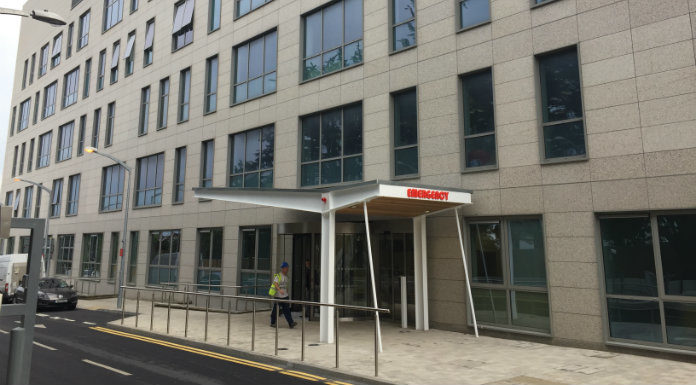The Government is being called on to take urgent action to prevent record levels of overcrowding at the region’s main hospital over the coming winter season.
Trolley numbers climbed to 57 at University Hospital Limerick yesterday morning, well above typical numbers for this time of year, following an unexpected surge in patients attending at Dooradoyle over the past number of days.
Clare’s Fianna Fáil TD says overcrowding has now reached “crisis levels”, and fears the situation will worsen over the coming months.
Funds have been approved for the design stage of an 96-bed extension to the department, but Deputy Timmy Dooley says the process needs to be sped up:
UL Hospitals Response:
The ED in University Hospital Limerick is the busiest in the country with over 64,000 attendances in 2016. The numbers presenting continues to increase year-on-year and of those presenting, the proportion requiring admission, including many frail elderly patients, has also increased.
Traditionally, average attendances at the ED have been approximately 150 over a 24-hour period from Mon – Fri and 120 per 24 hours at weekends. In recent weeks activity has been very high, there were 210 attendances in the 24 hour period from 8am on 22nd of August to 8am on the 23rd of August.
The new ED has designated spaces for 49 patients and admitted patients waiting for a bed are often in single rooms or designated bays. While patients still face long delays in the new ED, it provides for a much improved patient experience compared to the old department. The number of designated beds/cubicles has increased, the number for “minor” injuries has increased from 3 to 10; majors from seven to 12; paediatrics from six to eight; CDU from nine to 12 and adult resus bays from three to seven. Triage times have also improved which means that patients are being seen quicker by clinicians.
A t 8.00am on the 23rd of August there were 54 attendances in the Emergency Department. 35 of those patients were admitted patients waiting for a hospital bed, this figure is based on the HSE’s Trolleygar, published three times daily , 8am, 2pm and 8pm which measures admitted patients waiting in the Emergency Department for a hospital bed. The Trolleygar number typically reduces over the course of the day, as patients are discharged or transferred freeing up capacity in the ED, at 2pm there were 28 admitted patients waiting in the ED. Also in the department at the time were non-admitted patients waiting to be assessed or treated, waiting for diagnostics tests or waiting to be discharged home etc.
UL Hospitals Group was aware of international research suggesting attendances could increase with the opening of a new ED. The long-term trend remains to be seen but the increase to date has been in line with expectations. Almost 100 additional staff have been recruited for the new ED.
In addition to the increased volumes of patients attending, increased complexity and acuity is also a factor. The number of patients attending the ED requiring admission has increased by 9.3% in the year-to-date, (January to July 2017), there has been a 2.4% increase in attendances and a 3.6% increase in attendances by the over 75s.
While traditionally, ED attendances were higher in Winter months, this has not been the case at UHL in recent years. There were 15,861 attendances in Q1 2017 and this rose to 17,069 in the second quarter.
Overcrowding is a whole-hospital issue and not an issue strictly for the ED. UL Hospitals Group was consistent in its message in advance of opening that the new ED would not spell an end to the phenomenon of admitted patients waiting on trolleys. A multi-faceted approach is required in this regard encompassing additional bed capacity, improved patient flow, the development of integrated care programmes with community services – all of which are being addressed by the Group – and other measures.
UL Hospitals Group regrets that any patient has to face long waits in our ED during busy periods. There are many reasons why patients experience long wait times. In the context of older persons, longer wait times can be as a result of intervention in the ED by a ‘Frail Elderly Assessment Team’ whose primary aim is to assess, treat and discharge the patient, in preference to assessing and admitting the patient.
A number of measures are taken to relieve pressure on the ED in line with our escalation plan. Among the measures taken to relieve pressure on the ED are: the transfer of suitable patients from UHL to Ennis Hospital, Nenagh Hospital, St John’s Hospital and Croom Orthopaedic Hospital; the transfer of appropriate patients to community care settings; working closely with Community Intervention Teams to provide antibiotics and other basic care in a patient’s home or care facility; communication with GPs to ensure patients are referred to ED only where appropriate; extra ward rounds; and as a last resort, extra beds are put on wards.
UHL has 400 inpatient beds and this is recognised as not being sufficient for the needs of the MidWest Region. A bid to build an additional 96 bed block on the UHL site has been submitted to the Department of Health and approval has been granted for funding of the design stage of the build.
Plans to open a 17-bed short stay unit for medical patients in the old ED are well advanced and it is expected the unit will open in the near future.








